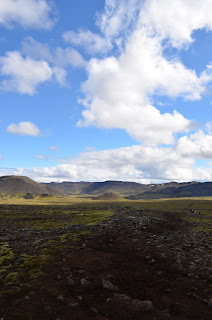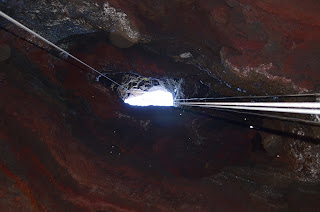It may have taken 28 hours, 3 flights and a massive layover
in Heathrow but finally arriving into the land of Fire & Ice was worth the
long haul. The major airport in Keflavik is about an hour
bus ride from Reyjkavik but a quick stint on the FlyBus and I found myself downtown
at minimal expense (+ bonus all buses have free Wi-Fi). Although Room with a View purports itself to
be “luxury apartments” the complex has seen more halcyon days but it is located
on the major shopping street in the centre of Reyjkavik. All it needs is a good spruce really but the
bed is comfortable and the apartment contains a kitchen (no single table
syndrome on a nightly occasion) and some great views of the sea, mountains and
city.
My first full day in Iceland was all about exploring
Reyjkavik itself. Being a compact city I
decided to see if I could tackle most things by foot. It’s hard to miss it so I made it my first
stop, the dominating Hallgrimskirkja, which is unmissable from every angle of
the city (apparently it’s visible up to 20km away). Regardless of its dominance it’s actually a
great signpost from which to get your bearings. The buildings dramatic exterior is
juxtapose by a weirdly subdued inside but does contain an intimidating 5275
pipe organ. On entering the cathedral I
was treated to the rehearsals for a concert occurring night which provided a
stunning accompaniment to the ride to the top of the tower where I snapped some
lovely views of the city and surrounds.

Everything I’d read on Iceland’s capital mentioned the
excellent National Museum, which was my next intended stop, but on route I got
distracted by densely wooded and magical Suourgata Cemetery. That’s another city and another major cemetery
under my belt – never knew it’d turn into a “thing”. As the rain bucketed down the National
Museum provided much needed shelter and a great insight into Icelandic history
from Pagan occupation to present.
From the small bronze model of Thor, that greets you on arrival to the 2nd
floor, to the impressive 12th Century VlaPjofsstaour Door the Museum provides a
digestible step-through Icelandic history.
Iceland is home to over 320 Pagan burial sites, the Heathen Graves,
which date back to 900AD and the remains of a woman and child from this era are
two of the most interesting and unsettling displays contained in the collection.

Icelanders know how to brew a good coffee and there’s
coffeehouses a plenty. After a quick
espresso in the compact Stofan Cafe it was off on the short walk (about 2km) to
the Saga Museum and Perlan which sits atop Oskjuhlio Hill (another crazy
architectural feat containing one of the world’s most lauded revolving
restaurants). Saga
Museum gets lots of good write-ups but not sure what all the fuss was about –
did not really bring the Sagas to life for me – but the view from atop Perlan
was worth the walk.
The following day was the first (of many) tours that I’ll be
doing on this trip and I decided to start with the “must do” or “most popular” Golden
Circle tour which takes in the stunning Gullfoss Waterfall, the geothermal
water spouts at Geysir and the birthplace of Viking democratic parliament in Pingvellir,
which also happens to be a dramatic craggy rift between the North American and
Euroasian tectonic plates.
The unexpected stop on the tour was to an organic farm which
grows tomatoes and cucumbers (what? In Iceland)
in greenhouses powered by Iceland’s abundant geothermal energy. Over 60% of Iceland’s fresh food is produced
in these greenhouses and tagged as such in the local supermarkets.
Iceland is home to an abundance of waterfalls and it seemed
fitting that my first Icelandic waterfall experience was Iceland’s most impressive,
the 32 meter double cascade drop that is Gulfoss (Golden Falls). Saved from hydro-electric damming in the 20’s
the falls were donated to the nation in the 70s and has become one of Iceland’s
most treasured tourist spots.
From water falling to water spouting the next stop on the
Golden Circle tour is the impressive water spouts at Geysir. Unfortunately the namesakes spout no longer
shoots impressive shards of water (due to tourists in the 50’s clogging the
spout with rocks) but a sister spout, Strokkur, shoots 30m plumes of water at
regular 10-12 minute intervals.
The final stop on the tour was the less spectacular but
equally as impressive Pingvellir National Park which contains the site of the first
Viking parliament.
Some fascinating Icelandic facts for a Friday…
·
Reyjkavik only has approx. 120K residents
·
Iceland is one of the least populated countries
in Europe with 3 people to every sq km
·
The Icelandic Horse is the only breed found in
the Country
·
Over 80
000 Icelandic Horses roam the countryside (and it’s legal to eat Horse)
·
If an Icelandic Horse is transported overseas it
may never return (to contain purity in breed)























